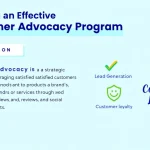Is this tool helpful?
How to Use the Brand Advocacy Program Generator
Follow these straightforward steps to create a comprehensive brand advocacy program:
- Enter your brand name in the first field (e.g., “Starbucks” or “Samsung”)
- Specify your target ambassadors (e.g., “loyal customers” or “industry professionals”)
- Input your industry type (e.g., “Retail” or “Healthcare”)
- Define program goals (optional but recommended)
- Outline reward structure (optional but recommended)
Understanding Brand Advocacy Program Development
A brand advocacy program is a structured initiative that transforms loyal supporters into active brand promoters. This generator streamlines the process of creating a tailored program that aligns with your business objectives and industry requirements.
Core Components of an Effective Brand Advocacy Program
- Ambassador identification and selection criteria
- Engagement strategies and communication channels
- Performance metrics and tracking mechanisms
- Reward systems and recognition programs
- Training and support infrastructure
Benefits of Using the Brand Advocacy Program Generator
Time and Resource Optimization
The generator significantly reduces the planning phase by providing:
- Structured program framework development
- Industry-specific recommendations
- Customized engagement strategies
- Scalable implementation guidelines
Enhanced Program Effectiveness
The tool ensures comprehensive coverage of essential elements:
- Target audience alignment
- Goal-oriented program structure
- Measurable outcomes definition
- Sustainable engagement mechanisms
Problem-Solving Capabilities
Strategic Planning Challenges
The generator addresses common program development hurdles:
- Ambassador selection criteria development
- Program structure optimization
- Resource allocation guidance
- Performance metric establishment
Implementation Roadmap
Creates a clear path for program execution:
- Timeline development
- Milestone identification
- Resource requirement planning
- Risk mitigation strategies
Practical Applications and Use Cases
Retail Industry Example
For a clothing retailer:
- Brand Name: “FashionFwd”
- Target Ambassadors: “Fashion enthusiasts and style bloggers”
- Industry Type: “Fashion Retail”
- Program Goals: “Increase social media presence and drive online sales”
- Reward Structure: “Free clothing items, early access to collections, exclusive event invitations”
Technology Sector Example
For a software company:
- Brand Name: “CloudTech Solutions”
- Target Ambassadors: “IT professionals and tech influencers”
- Industry Type: “Enterprise Software”
- Program Goals: “Generate qualified leads and increase brand credibility”
- Reward Structure: “Premium software access, certification programs, speaking opportunities”
Frequently Asked Questions
What makes a successful brand advocacy program?
A successful program combines clear objectives, engaged ambassadors, meaningful incentives, and consistent support. Key elements include regular communication, valuable rewards, and measurable outcomes.
How long does it take to implement a brand advocacy program?
Implementation timeline varies based on program scope and organizational readiness. Typically, basic programs can launch within 1-2 months, while comprehensive programs may take 3-6 months to fully implement.
What types of rewards work best for brand ambassadors?
Effective rewards vary by industry and ambassador type but often include:
- Exclusive product access
- Recognition and visibility opportunities
- Professional development resources
- Monetary or product-based incentives
How can I measure brand advocacy program success?
Key performance indicators typically include:
- Ambassador engagement rates
- Referral conversions
- Social media mention increases
- Brand sentiment improvements
- Revenue attribution to advocacy activities
Can small businesses benefit from brand advocacy programs?
Yes, small businesses can significantly benefit from advocacy programs by:
- Leveraging existing customer relationships
- Creating authentic word-of-mouth marketing
- Building community connections
- Maximizing limited marketing budgets
Should brand advocates be compensated?
While monetary compensation isn’t always necessary, providing value through various rewards helps maintain long-term engagement. Consider a mix of tangible and intangible benefits that align with ambassador motivations.
How often should I communicate with brand advocates?
Regular communication maintains engagement and program momentum. Consider:
- Weekly updates or newsletters
- Monthly virtual meetups
- Quarterly performance reviews
- Annual recognition events
What content should brand advocates share?
Effective advocate content includes:
- Personal success stories
- Product reviews and tutorials
- Behind-the-scenes insights
- Industry expertise and thought leadership
- Customer experience testimonials
Important Disclaimer
The calculations, results, and content provided by our tools are not guaranteed to be accurate, complete, or reliable. Users are responsible for verifying and interpreting the results. Our content and tools may contain errors, biases, or inconsistencies. We reserve the right to save inputs and outputs from our tools for the purposes of error debugging, bias identification, and performance improvement. External companies providing AI models used in our tools may also save and process data in accordance with their own policies. By using our tools, you consent to this data collection and processing. We reserve the right to limit the usage of our tools based on current usability factors. By using our tools, you acknowledge that you have read, understood, and agreed to this disclaimer. You accept the inherent risks and limitations associated with the use of our tools and services.







